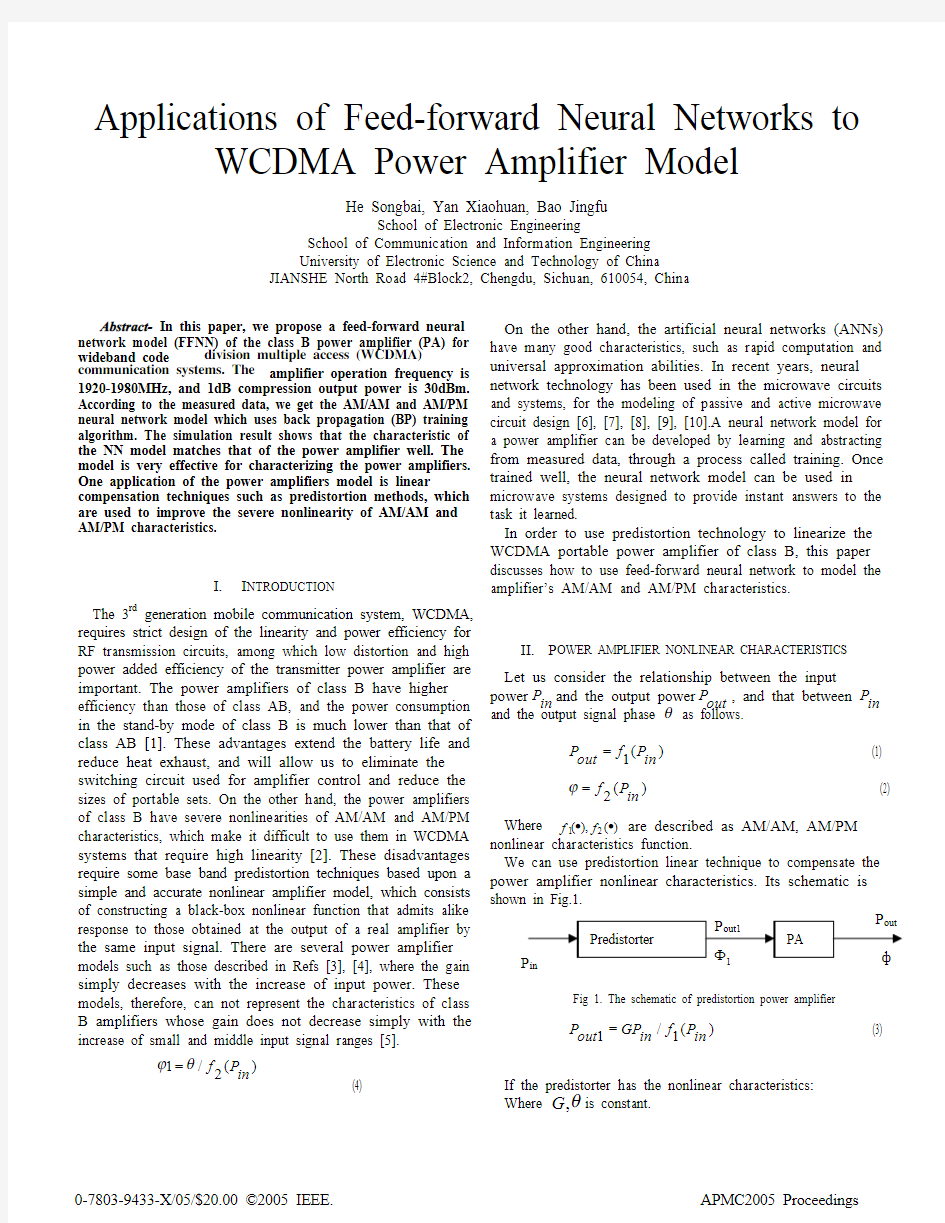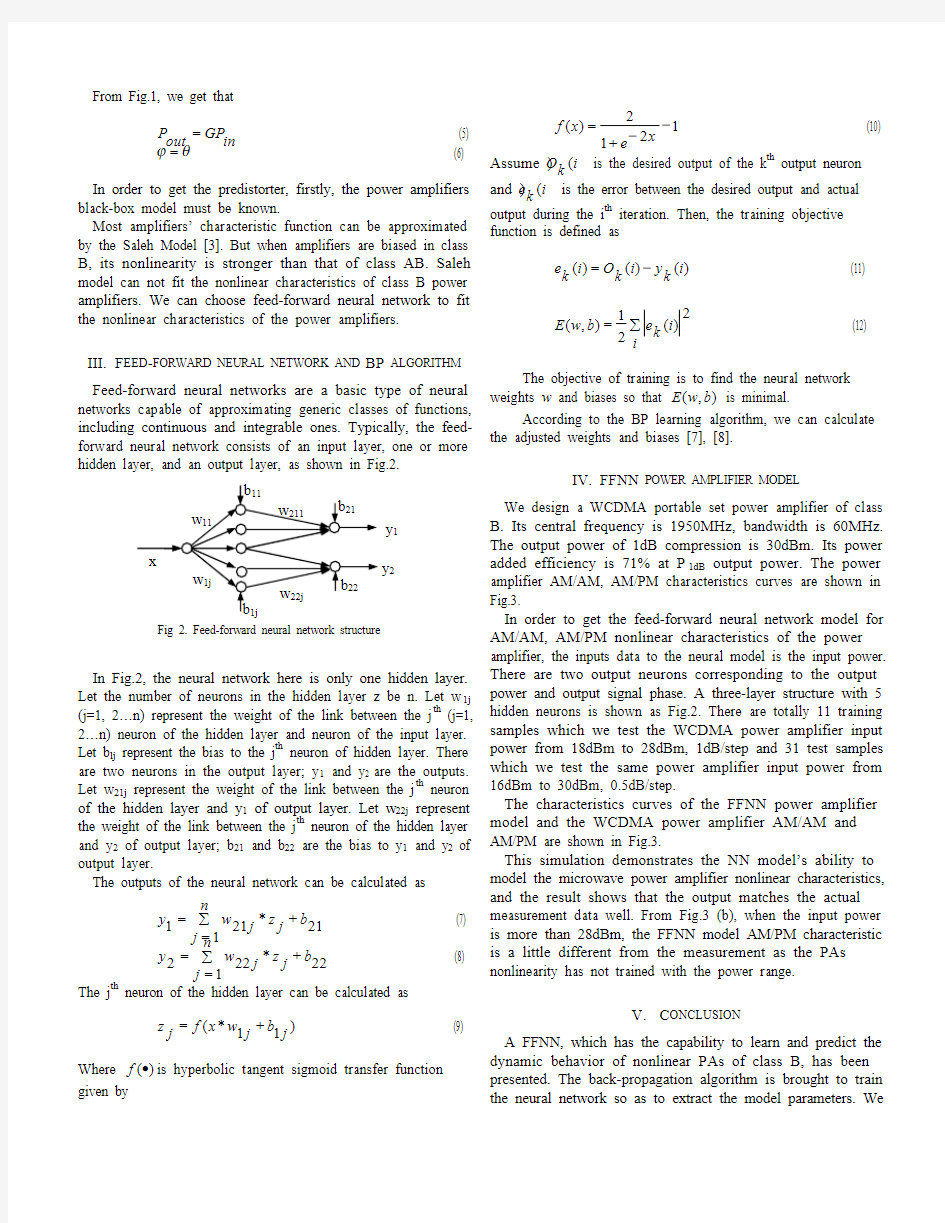Applications of Feed-forward Neural Networks to


Applications of Feed-forward Neural Networks to
WCDMA Power Amplifier Model
He Songbai, Yan Xiaohuan, Bao Jingfu
School of Electronic Engineering
School of Communication and Information Engineering University of Electronic Science and Technology of China JIANSHE North Road 4#Block2, Chengdu, Sichuan, 610054, China
Abstract- In this paper, we propose a feed-forward neural network model (FFNN) of the class B power amplifier (PA) for wideband code division multiple access (WCDMA)
communication systems. The amplifier operation frequency is 1920-1980MHz, and 1dB compression output power is 30dBm. According to the measured data, we get the AM/AM and AM/PM neural network model which uses back propagation (BP) training algorithm. The simulation result shows that the characteristic of the NN model matches that of the power amplifier well. The
model is very effective for characterizing the power amplifiers. One application of the power amplifiers model is linear compensation techniques such as predistortion methods, which are used to improve the severe nonlinearity of AM/AM and AM/PM characteristics.
I. I NTRODUCTION The 3rd generation mobile communication system, WCDMA, requires strict design of the linearity and power efficiency for
RF transmission circuits, among which low distortion and high
power added efficiency of the transmitter power amplifier are
important. The power amplifiers of class B have higher
efficiency than those of class AB, and the power consumption
in the stand-by mode of class B is much lower than that of
class AB [1]. These advantages extend the battery life and
reduce heat exhaust, and will allow us to eliminate the
switching circuit used for amplifier control and reduce the
sizes of portable sets. On the other hand, the power amplifiers
of class B have severe nonlinearities of AM/AM and AM/PM
characteristics, which make it difficult to use them in WCDMA
systems that require high linearity [2]. These disadvantages
require some base band predistortion techniques based upon a
simple and accurate nonlinear amplifier model, which consists
of constructing a black-box nonlinear function that admits alike
response to those obtained at the output of a real amplifier by
the same input signal. There are several power amplifier
models such as those described in Refs [3], [4], where the gain
simply decreases with the increase of input power. These
models, therefore, can not represent the characteristics of class
B amplifiers whose gain does not decrease simply with the
increase of small and middle input signal ranges [5].
On the other hand, the artificial neural networks (ANNs) have many good characteristics, such as rapid computation and universal approximation abilities. In recent years, neural network technology has been used in the microwave circuits and systems, for the modeling of passive and active microwave circuit design [6], [7], [8], [9], [10].A neural network model for a power amplifier can be developed by learning and abstracting from measured data, through a process called training. Once trained well, the neural network model can be used in microwave systems designed to provide instant answers to the task it learned. In order to use predistortion technology to linearize the
WCDMA portable power amplifier of class B, this paper
discusses how to use feed-forward neural network to model the
amplifier’s AM/AM and AM/PM characteristics.
II. P OWER AMPLIFIER NONLINEAR CHARACTERISTICS Let us consider the relationship between the input
power in P and the output power out P , and that between in P
and the output signal phase θ as follows.
)(1in P f out P = (1)
)(2in P f =? (2)
Where )(),(21??f f are described as AM/AM, AM/PM
nonlinear characteristics function.
We can use predistortion linear technique to compensate the
power amplifier nonlinear characteristics. Its schematic is
11in in out
)
(2/1in P f θ?= (4) If the predistorter has the nonlinear characteristics:
Where θ,G is constant.
0-7803-9433-X/05/$20.00 ?2005 IEEE. APMC2005 Proceedings
From Fig.1, we get that
in GP out P = (5) θ?= (6)
In order to get the predistorter, firstly, the power amplifiers black-box model must be known. Most amplifiers’ characteristic function can be approximated by the Saleh Model [3]. But when amplifiers are biased in class B, its nonlinearity is stronger than that of class AB. Saleh model can not fit the nonlinear characteristics of class B power amplifiers. We can choose feed-forward neural network to fit the nonlinear characteristics of the power amplifiers.
III. F EED -FORWARD NEURAL NETWORK AND BP ALGORITHM Feed-forward neural networks are a basic type of neural
networks capable of approximating generic classes of functions, including continuous and integrable ones. Typically, the feed-forward neural network consists of an input layer, one or more hidden layer, and an output layer, as shown in Fig.2.
In Fig.2, the neural network here is only one hidden layer. Let the number of neurons in the hidden layer z be n. Let w 1j (j=1, 2…n) represent the weight of the link between the j th (j=1, 2…n) neuron of the hidden layer and neuron of the input layer. Let b lj represent the bias to the j th neuron of hidden layer. There are two neurons in the output layer; y 1 and y 2 are the outputs. Let w 21j represent the weight of the link between the j th neuron of the hidden layer and y 1 of output layer. Let w 22j represent the weight of the link between the j th neuron of the hidden layer and y 2 of output layer; b 21 and b 22 are the bias to y 1 and y 2 of output layer.
The outputs of the neural network can be calculated as 211
*211b n
j j z j w y +∑== (7)
221*222b n j j z j w y +∑== (8)
The j th
neuron of the hidden layer can be calculated as
)11*(j b j w x f j z += (9)
Where )(?f is hyperbolic tangent sigmoid transfer function given by
1212
)(??+=
x e
x f (10) Assume )(i k O is the desired output of the k th output neuron
and )
(i k e is the error between the desired output and actual output during the i th iteration. Then, the training objective function is defined as )()()(i k y i k O i k e ?= (11)
2)(21),(∑=i i k e b w E (12)
The objective of training is to find the neural network weights w and biases so that ),(b w E is minimal.
According to the BP learning algorithm, we can calculate the adjusted weights and biases [7], [8].
IV. FFNN POWER AMPLIFIER MODEL
We design a WCDMA portable set power amplifier of class B. Its central frequency is 1950MHz, bandwidth is 60MHz. The output power of 1dB compression is 30dBm. Its power added efficiency is 71% at P 1dB output power. The power amplifier AM/AM, AM/PM characteristics curves are shown in Fig.3.
In order to get the feed-forward neural network model for AM/AM, AM/PM nonlinear characteristics of the power amplifier, the inputs data to the neural model is the input power. There are two output neurons corresponding to the output power and output signal phase. A three-layer structure with 5 hidden neurons is shown as Fig.2. There are totally 11 training samples which we test the WCDMA power amplifier input power from 18dBm to 28dBm, 1dB/step and 31 test samples which we test the same power amplifier input power from 16dBm to 30dBm, 0.5dB/step.
The characteristics curves of the FFNN power amplifier model and the WCDMA power amplifier AM/AM and AM/PM are shown in Fig.3.
This simulation demonstrates the NN model’s ability to model the microwave power amplifier nonlinear characteristics, and the result shows that the output matches the actual measurement data well. From Fig.3 (b), when the input power is more than 28dBm, the FFNN model AM/PM characteristic is a little different from the measurement as the PAs nonlinearity has not trained with the power range.
V. C ONCLUSION
A FFNN, which has the capability to learn and predict the dynamic behavior of nonlinear PAs of class B, has been presented. The back-propagation algorithm is brought to train the neural network so as to extract the model parameters. We
can implement the FFNN model into an adaptive predistorter
for linearizing a power amplifier. Of course, we can use neural network to construct the predistorter. Our next research is using the FFNN power amplifier model to realize the adaptive base band predistorter linearizing power amplifier of class B.
R EFERENCES
[1] Steve C.Cripps, RF Power Amplifiers for Wireless Communications,
Artech House, Boston, chapter 7,9, 1999.
[2] Ulrich L.Rohde, David P.Newkirk, RF/Microwave Circuit Design for
Wireless Applications, Wiley Interscience, John Wiley & Sons, Inc.
Chapter 3, 2000.
[3] A.A.M.Saleh, “Frequency independent and frequency dependent nonlinear
models of TWT amplifiers,” IEEE Trans. Commun., https://www.sodocs.net/doc/3910289741.html,-29, no.11, pp.1715-1720, Nov. 1981.
[4] K.J.Muhonen, M.Kavehrad, and R.Krishnamoorthy, “Look up table
techniques for adaptive digital predistortion: A development and comparision,” IEEE Trans. Veh. Techol., vol.49,no.5,pp.1995-2002, Sept.
2000.
[5] Fumitaka Iizuka, Tsuyoshi O gino, etc. “A power amplifier model
considering drain current dependence upon input power for high efficiency transmitter power amplifiers in mobile communications”, IEICE Trans.
Electron ., Vol.E87-C, No.5, May,2004.
[6] Taijun Liu, Slim Boumaliz, Fadhel M.Ghannouychi, “Dynamic behavioral
modeling of 3G power amplifiers using real valued time delay neural networks”, IEEE Trans. Microwave Theory and Techniques, Vol.52, No.3, pp1025-1033, March 2004.
[7] Hong-min Deng, Song-bai He, Jue-bang Yu, “An adaptive predistorter
using modified neural networks combined with a fuzzy controller for nonlinear power amplifiers”, Int. J. RF and Microwave CAE 14, pp15-20, 2004.
[8] Chunguang Li, Songbai He, Xiaofeng Liao, Juebang Yu, “Using recurrent
neural network for adaptive predistortion linearization of RF amplifiers”, Int. J. RF and Microwave CAE 12, pp125-130, 2002.
[9] P. Burrascano, S. Fiori, M. Mongiardo, “A Review of Artificial Neural
Networks applica-tions in Microwave Computer-Aided Design”, Int. J. RF and Microwave CAE 9, pp158-174, 1999.
[10] Fang Wang, Vijaya K. Devabhaktuni, Changgeng Xi, Qi-Jun Zhang,
“Neural Network Structures and Training Algorithms for RF and Microwave applications”, Int. J. RF and Microwave CAE 9, pp216-240, 1999.
Fig 3. The characteristics curves of the FFNN power amplifier model and the WCDMA power amplifier AM/AM and AM/PM
